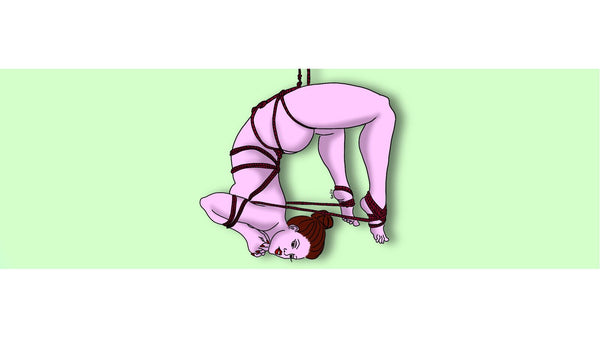Beautiful Rope: The Mysterious World Of Shibari

Read about the author Alice Hunter
Wanting to spice things up in the bedroom? Feel like trying something naughty but nice? Not all BDSM (Bondage, domination, submission and masochism) involves dungeons, latex or even pain.
For those with a relatively conventional sexual history, the allure of some rope-tying can seem like a safe and sexy addition to one’s bedroom repertoire. A silk scarf around the wrists, a blindfold and even being tied to the bed can be a fun role-play element with someone you trust, yet it is only the tip of the iceberg.
For a true sense of the beauty and power of rope, look no further than the Japanese art of rope tying: Shibari.
To truly understand the allure of rope bondage, one must travel much further down the rabbit hole than buying a few feet of cotton cord and trying to figure out how to use it. Fortunately, the Shibari rope world is very accessible to those who don’t necessarily see themselves as part of a ‘kink scene’ (as well as those who do). It is quite normal and acceptable for a single person or couple to book onto a rope workshop for beginners, where you will have a fun day out, spend some quality time with your partner, learn some basic skills, and get to meet the experienced masters of Shibari in all their glory.
Workshops are rarely held in dark dungeons- think more a yoga studio ambiance, with professional equipment and instruction. Rope ties photograph beautifully, the process is intense and intimate- relaxing, challenging and spiritual in feeling. If you are looking for a new hobby to do together, to learn a skill that can be considered either sexual or ‘respectable’, to challenge your mind, body and explore the nature of intimacy with another, then taking up Shibari is the journey for you.
At a workshop, you will learn about the appropriate types of rope to use, the gentle, sensual pace of the process and start understanding some important basics of anatomy, the terminology and the physics involved in tying someone safely. Despite rope seeming like the ‘softer’ end of the kink scale, it is certainly one of the acts that is the most dangerous if done wrong, and for this reason it’s really important to get proper instruction from someone qualified and experienced, who will take you from beginner-safe ties to the more advanced techniques and possibilities, like suspending your partner in the air.
If you loved knots as a boy scout or learning to sail you will have a starting advantage, but it is not all about the knots. There are elements of tension and balancing of bodyweight safely that have to be developed, and there is the process of how the rigger (the one doing the tying) soothes and relaxes the rope bunny (one being tied), making it into a sensuous journey of trust and sublime spiritual meditation.
If these descriptions sound rather grand and complex, it’s because they are. Experienced Shibari rope riggers spend years, practicing many hours every week, before they become skilled enough to perform the ties safely and make it all look easy.
That is not to say you won’t be able to learn some fun ties on your very first session- you will gain a lot – but expecting to come in and safely suspend someone in the air in a complex rope tie is the equivalent to expecting to break bricks with a karate chop at your first martial arts lesson. It is a labour of love, and commitment. It is a journey, that one can dabble in lightly with small expectations, or take all the way to expert status, developing their art form, skills and mindset all the time.
I spoke to the experienced Shibari instructor, Hiigara Rope, in a recent interview about the world of Shibari. He had some top tips for complete beginners curious about Shibari and Kinbaku- two words you will hear largely interchangeably among the aficionados of the Japanese art of rope tying.

Image Credits Photography AmeliaRoslyn Featuring Mili-ficent
Why try rope?
The best thing about rope is the connection and intimacy it creates.
Is rope sexual?
For some people it’s very sexually charged, for others it is all about trust and submission. It depends on the dynamic they have together.
Is it painful to be tied?
It can be, but it doesn’t have to be. For some people, pain is part of the allure, but for others it is much softer and more comforting. There is a Japanese concept of ‘beautiful suffering’ – but that doesn’t necessarily mean the rope is tense. It can be very emotional and vulnerable.
Is learning Shibari open to everyone?
All body shapes can be tied, all gender identities, sexualities and relationship styles are welcome.
If someone can’t attend a workshop, how can they do rope safely?
Definitely keep it on the ground, avoid dangerous areas like the neck. Keep some cutting shears close by and don’t be afraid to cut the rope if needed. If you don’t want to go down the full technical route of learning rope, focus more on the sensuality and connection.
What kind of rope should be used?
It depends what you are doing. Proper Shibari will use natural fibre jute, but there are other types which work well for different things.
Where can someone find a beginner Shibari rope tying class?
If you have a Fetlife account, you can use it to find a list of all the rope events near you. If you are in London, there is, of course, Anatomie Studio, or Studio Kokoro In the Midlands. Your local Peer Rope group will be a great entry point to start learning the basics of how to tie. There are also lots of good books available.
Is it hard to join a new class and learn the lingo?
I was terrified of the first event I went to – at how I’d be perceived – but I found the people were really friendly and interested in helping me to be sound. Once you get started the lingo becomes sensible quite quickly. I’ve travelled all over the world and found that rope people are the friendliest I’ve ever met.
What is the difference between tying and being tied?
Being tied is very erotic- you are giving up power and control to another person. It can also feel personally challenging- you are being pulled this way and that and your body is experiencing new sensations. When tying? Receiving someone’s submission is a wonderful gift and there is also the technical side- the expertise and engineering puzzles to figure out while someone is in the air. Thirdly, you have that sense of connection.
Is there a lot of friendship and community?
It’s absolutely huge. I’ve met many friends and partners at rope, and those relationships have stayed with me through the years
Can you go from being completely conventional to being into rope, without being a part of any wider BDSM scene?
Absolutely. Some people only do rope, some are also into the kink scene. There is a huge cross-over but it’s a case of ‘go as deep as you want to go’. Rope people are vanilla people in different clothing.
What’s the worst faux pas you could make at your first workshop?
Assuming all the women are the ones who want to be tied, rather than doing the tying. Or picking up someone else’s rope without asking.
(Interview with Shibari Master Hiigara-Ropes summarised from the full interview.)
So, is learning the complex beauty of rope tying for you? Is it really so different from crochet? Is it more than a bit of bedroom fun? It absolutely can be. It can be a spiritual practice that transforms one’s partnership, sense of self and social circle, or it can be just a cool new hobby class to try out.
“Rope is like a hug, that can be given many different ways” Opalfruit, shibari rigger and Peer Rope organiser
The joy of every journey is that you never know when it will start, or where it might end. More interesting than this, is the question of who you will be. What will you have learned, how will you have grown, and how will your world have blossomed?
“Bondage is of the mind; freedom too is of the mind” Ramakrishna
It is not recommended to try Shibari or other rope-tying without first taking professional instruction

